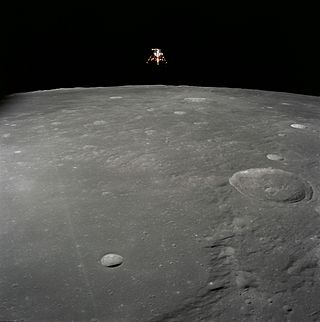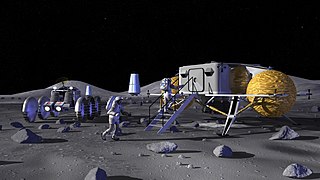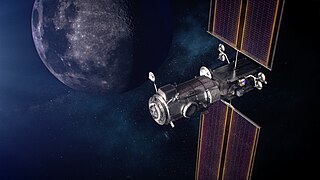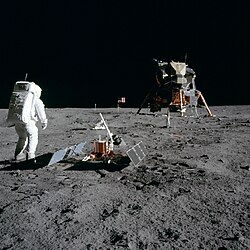
The Soyuz programme is a human spaceflight programme initiated by the Soviet Union in the early 1960s. The Soyuz spacecraft was originally part of a Moon landing project intended to put a Soviet cosmonaut on the Moon. It was the third Soviet human spaceflight programme after the Vostok (1961–1963) and Voskhod (1964–1965) programmes.
Human spaceflight programs have been conducted, started, or planned by multiple countries and companies. Until the 21st century, human spaceflight programs were sponsored exclusively by governments, through either the military or civilian space agencies. With the launch of the privately funded SpaceShipOne in 2004, a new category of human spaceflight programs – commercial human spaceflight – arrived. By the end of 2022, three countries and one private company (SpaceX) had successfully launched humans to Earth orbit, and two private companies had launched humans on a suborbital trajectory.

Colonization of the Moon is a process or concept employed by some proposals for robotic or human exploitation and settlement endeavours on the Moon. Settling of the Moon is, therefore, a more specific concept of lunar habitation, for which the broader concept of colonization is often used as a synonym, a use that is contested in the light of colonialism.

The Exploration Systems Architecture Study (ESAS) is the official title of a large-scale, system level study released by the National Aeronautics and Space Administration (NASA) in November 2005 of his goal of returning astronauts to the Moon and eventually Mars—known as the Vision for Space Exploration. The Constellation Program was cancelled in 2010 by the Obama Administration and replaced with the Space Launch System, later renamed as the Artemis Program in 2017 under the Trump Administration.

The physical exploration of the Moon began when Luna 2, a space probe launched by the Soviet Union, made a deliberate impact on the surface of the Moon on September 14, 1959. Prior to that the only available means of exploration had been observation from Earth. The invention of the optical telescope brought about the first leap in the quality of lunar observations. Galileo Galilei is generally credited as the first person to use a telescope for astronomical purposes; having made his own telescope in 1609, the mountains and craters on the lunar surface were among his first observations using it.

The Chinese Lunar Exploration Program, also known as the Chang'e Project after the Chinese Moon goddess Chang'e, is an ongoing series of robotic Moon missions by the China National Space Administration (CNSA). The program encompasses lunar orbiters, landers, rovers and sample return spacecraft, launched using the Long March series of rockets. A human lunar landing component may have been added to the program, after China publicly announced crewed lunar landing plans by the year 2030 during a conference in July 2023.

The Crew Exploration Vehicle (CEV) was a component of the U.S. NASA Vision for Space Exploration plan. A competition was held to design a spacecraft that could carry humans to the destinations envisioned by the plan. The winning design was the Orion spacecraft.

The following outline is provided as an overview of and topical guide to space exploration.

NASA proposed several concept moonbases for achieving a permanent presence of humans on the Moon since the late 1950s. Research and exploration of the Moon has been a large focus of the organization since the Apollo program. NASA's peak budget was in 1964-1965, when it comprised 4% of all federal spending in service of the Apollo Moon landing project. Though lunar landings ever since the conclusion of the Apollo program in 1972 have ceased, interest in establishing a permanent habitation on the lunar surface or beyond low Earth orbit has remained steady. Recently, renewed interest in lunar landing has led to increased funding and project planning. NASA requested an increase in the 2020 budget of $1.6 billion, in order to make another crewed mission to the Moon under the Artemis program by 2025, followed by a sustained presence on the Moon by 2028. A crew was selected for the planned crewed mission, Artemis II, in April 2023.

The Space Exploration Initiative was a 1989–1993 space public policy initiative of the George H. W. Bush administration.

The National Aeronautics and Space Administration is an independent agency of the U.S. federal government responsible for the civil space program, aeronautics research, and space research. Established in 1958, it succeeded the National Advisory Committee for Aeronautics (NACA) to give the U.S. space development effort a distinct civilian orientation, emphasizing peaceful applications in space science. It has since led most of America's space exploration programs, including Project Mercury, Project Gemini, the 1968–1972 Apollo Moon landing missions, the Skylab space station, and the Space Shuttle. Currently, NASA supports the International Space Station along with the Commercial Crew Program, and oversees the development of the Orion spacecraft and the Space Launch System for the lunar Artemis program.
Zvezda moonbase, also called DLB Lunar Base, was a Soviet plan and project from 1962 to 1974 to construct a crewed moonbase as successor to the N1-L3 human lunar expedition program. Zvezda moonbase was canceled with the rest of the Soviet human lunar programs.

The Lunar Gateway, or simply Gateway, is a space station which Artemis program participants plan to assemble in an orbit near the Moon. The Gateway is intended to serve as a communication hub, science laboratory, and habitation module for astronauts. It is a multinational collaborative project: participants include NASA, the European Space Agency (ESA), the Japan Aerospace Exploration Agency (JAXA), the Canadian Space Agency (CSA) and the Mohammed Bin Rashid Space Centre (MBRSC). The Gateway is planned to be the first space station beyond low Earth orbit.

The Artemis program is a Moon exploration program that is led by the United States' NASA and was formally established in 2017 via Space Policy Directive 1. The Artemis program is intended to reestablish a human presence on the Moon for the first time since Apollo 17 in 1972. The program's stated long-term goal is to establish a permanent base on the Moon to facilitate human missions to Mars.

Artemis 4 is a planned mission of the NASA-led Artemis program. The mission will include the fourth use of a Space Launch System (SLS) launch vehicle, will send an Orion spacecraft with four astronauts to the Lunar Gateway space station, install a new module on the Gateway, and conduct the second lunar landing of the Artemis program.
HERACLES is a planned robotic transport system to and from the Moon by Europe (ESA), Japan (JAXA) and Canada (CSA) that will feature a lander called the European Large Logistic Lander, a Lunar Ascent Element, and a rover. The lander can be configured for different operations such as up to 1.5 tons of cargo delivery, sample-returns, or prospecting resources found on the Moon.

The International Lunar Research Station (ILRS) (Chinese: 国际月球科研站) is a planned lunar base currently being led by Roscosmos and the China National Space Administration (CNSA). The ILRS will serve as a comprehensive scientific experiment base built on the lunar surface or in lunar orbit that can carry out multi-disciplinary and multi-objective scientific research activities including exploration and utilization, lunar-based observation, basic scientific experiment and technical verification, and long-term autonomous operation. Statements from Roscosmos and CNSA underline that the project will be "open to all interested countries and international partners."

The International Habitation Module, International Habitat or I-HAB is designed as a habitat module of the Lunar Gateway station, to be built by the European Space Agency (ESA) in collaboration with the Japan Aerospace Exploration Agency, or JAXA. The I-HAB will have a maximum launch mass of 10,000 kg (22,000 lb) and provide a habitable volume of 10 m3 (350 cu ft).



















